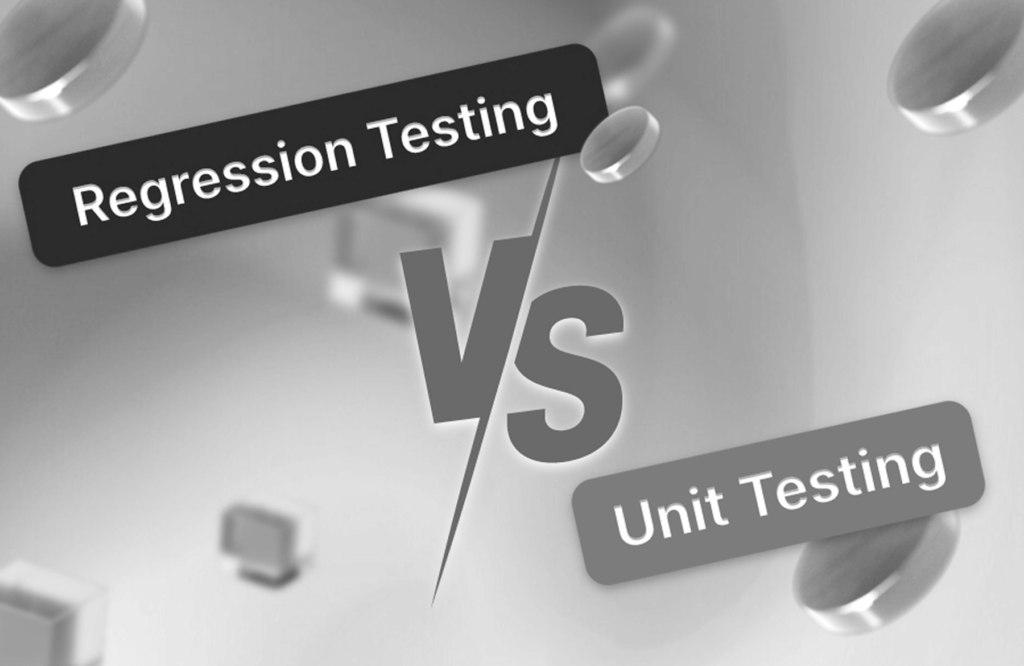Regression Testing VS Unit Testing: What is the Difference?


Despite their shared goal of ensuring quality, unit testing and regression testing serve distinct purposes and play different roles in the software lifecycle. In this article, we’ll delve into the comparison of unit testing vs. regression testing, the benefits of each, and how they complement each other to ensure robust software.
What is a unit test?
Unit testing tests the individual functions, components, or blocks of code. It ensures these parts work perfectly on their own before they’re pieced together into a bigger system. This precise focus ensures that an application’s foundational building blocks work flawlessly before moving on to more extensive testing phases.
Example: testing a function that calculates the sum of two numbers ensures that it returns accurate results for a variety of inputs.
Unit testing requires a high degree of expertise, as specialists must deeply understand the systems they are testing. They need the skills and experience to handle unique systems-whether it’s PL/SQL expertise, programming language mastery, or years working with a specific platform.
Where unit testing fits in development and what makes it different?
It’s no secret that developing or revising any feature involves changes across multiple system levels. Each unit tester is responsible for verifying new functionality within the boundaries of their system. The code is tested directly without relying on the user interface. Test data isn’t chosen randomly; instead, it’s carefully selected to cover the maximum number of output parameter variations with a minimal dataset. The top priority is ensuring the functional and technical correctness of the code.
What sets unit testing apart from other types of testing?
First, it focuses on the code itself, ensuring the immutability of recorded contracts and output parameters. If these remain intact, the feature can integrate seamlessly with other systems.
Second, specialized expertise significantly reduces the time needed to test revisions. While integration testing evaluates the feature as a whole, unit testing breaks it down into smaller, manageable parts, allowing for faster and more precise validation.
What specific tasks does unit testing solve?
- It tests functionality within the context of the specific system.
- It verifies that the code not only processes correct data but also handles errors and exceptions appropriately.
- It ensures the functionality is handed off to integration testing free of critical bugs or blocking defects.
Of course, it can also be mentioned that catching errors during development-or immediately after-saves time and minimizes disruptions. Similarly, a clearly defined bug at the code level is far easier for developers to address than a vague issue discovered later in the process.
What is regression testing?
Regression testing is a critical process performed after changes have been made to an application. Primary benefits of regression testing include ensuring that existing functionality continues to work as expected, even after updates or modifications, and avoiding costly rollbacks or bug fixes later. This is closely tied to unit testing, as unit tests often serve as the foundation for identifying and addressing potential issues before they can affect broader functionality. Together, these testing methods create a robust safety net for the application.
Take, for example, an online store with core functions such as product search, adding items to a cart, editing the cart, and placing orders. When a new version of the store is released, regression testing ensures that these features-already working in earlier versions-still function correctly in the updated application.
Functions to test in regression testing:
- Verify that users can search for products by name and receive accurate results.
- Ensure that selected items are added to the shopping cart without errors.
- Confirm that items can be removed correctly.
- Check that users can adjust quantities or remove items before placing an order.
- Validate that orders are processed correctly with the selected products.
Each of these functions needs to be tested to confirm their stability and reliability in the new version.
Regression testing complements unit testing by addressing broader scenarios. While unit testing ensures individual components or modules work as expected, regression testing validates that these components, once integrated, don’t disrupt existing functionality. Together, they provide confidence that users will have a seamless experience, even after changes are introduced. When both testing approaches are implemented effectively, they help developers detect and resolve issues early, maintaining the application’s quality and user satisfaction.
Regression testing types
Regression tests can take many forms, such as
- Retest-all: Running the entire test suite to ensure no part of the application is broken.
- Selective regression: Testing only the affected components and their dependencies.
- Progressive regression: Testing new code changes in isolation while maintaining compatibility with old functionalities.
- Corrective regression: Testing areas where bugs were previously identified to ensure fixes have resolved the issue.
[blog-subscribe]
Key differences between unit testing and regression testing
Unit and regression testing serve different purposes in the software development process, though they often complement each other. Here’s a simple breakdown:
Purpose
- Unit testing checks individual components or pieces of code to ensure they work correctly on their own. It’s focused and precise, dealing with small, isolated parts of the application.
- Regression testing ensures that the entire application continues to work as expected after changes (like updates or bug fixes). It looks at the big picture to verify that new changes haven’t broken existing functionality.
When it’s done
- Unit testing happens early in development, typically as code is being written. It’s often performed by developers or specialized unit testing engineers.
- Regression testing happens later, after changes are implemented and integrated, and is often handled by testers or automation tools.
Focus
- Unit testing focuses on the technical and functional correctness of specific blocks of code, such as functions, methods, or classes.
- Regression testing focuses on ensuring the stability of the overall system and that previously working features still work after modifications.
Automation
- Unit tests are highly automatable, often written by developers using frameworks like JUnit, NUnit, or pytest. These automated unit tests can later become part of the regression test suite.
- Regression testing also involves automation but is broader, often using end-to-end test tools like Selenium or TestComplete to simulate user behavior.
Agile vs. Waterfall approach
Unit and regression testing also differ in how they’re applied in Agile and waterfall methodologies.
- Agile testing is continuous and iterative.
Unit tests are frequently written and run as developers create new code. Automated unit tests are integrated into CI/CD pipelines and are often included in sprint-level regression packs. This ensures that any new changes don’t disrupt progress and that the software remains stable at every stage.
Regression testing in Agile is run at the end of every sprint or release cycle to confirm the stability of completed tasks. - Waterfall testing is done in distinct phases after development is complete.
Unit testing occurs once a section of the application is developed, and regression testing is performed only after all the features are integrated. This linear approach makes it harder to catch issues early, as testing happens much later in the cycle.
Automating unit testing and its role in regression testing
If the unit testing team includes an automation specialist, automated unit tests become a powerful tool. These tests can be written using any preferred framework (like JUnit, pytest, or xUnit) or as scripts that are grouped into a single test pack. These packs can be scheduled or triggered on demand, providing instant validation of code changes.
Here’s where unit and regression testing meet: automated unit tests don’t just end at the unit testing phase. They’re included in a regression test suite, which combines automated unit tests with broader tests created by the automation team. This suite runs regularly-before sprint tasks are completed or before a release goes live-to catch potential issues early.
What does this give? A highly efficient safety net. Automated tests mean faster feedback, fewer bugs slipping through, and a more stable product. The benefits are clear: less time spent on manual testing, fewer risks, and confidence in both the small details and the bigger picture.
By combining the strengths of unit and regression testing, teams can deliver reliable, high-quality software in today’s fast-paced development environments.
Tools in unit and regression testing
Many tools support both unit testing and regression testing, offering versatility across the development lifecycle. These tools help test individual components while also ensuring that changes don’t disrupt existing functionality.
Frameworks for unit testing can often be expanded to support regression testing by integrating them with automation and test management tools.
- JUnit (Java) is primarily for unit testing, but its tests can be reused and included in broader regression test suites.
- pytest (Python) handles unit tests efficiently, while its powerful plugins allow integration into regression packs.
- NUnit (.NET) is ideal for unit tests, with features like test case reusability and integration with CI/CD pipelines for regression testing.
- Mocha/Chai (JavaScript) is used for both unit and regression tests in JavaScript applications, especially when paired with automation libraries.
CI/CD integration tools
Continuous integration and deployment pipelines help combine unit and regression testing into an automated workflow.
- Jenkins executes unit tests as code is written and reruns those tests in broader regression packs after updates.
- GitLab CI/CD automatically runs unit and regression tests as part of its build pipelines.
- Azure DevOps supports both unit and regression testing with robust reporting and integration features.
Test management and collaboration tools
These tools help organize and manage both unit and regression tests, ensuring better tracking and reporting.
- TestRail tracks both unit and regression test cases, making it easy to integrate them into automation workflows.
- Zephyr manages test cases for both unit and regression testing, with Jira integration for team collaboration.
Combining unit tests with regression testing
In modern workflows, automated unit tests often serve as the foundation for regression testing.
- If there’s an automation specialist in the unit testing team, they create a set of tests using frameworks like JUnit or pytest. These can be compiled into regression packs.
- Regression packs combine automated unit tests with additional tests for broader scenarios using tools like Selenium or Cypress.
- These regression packs are integrated into pipelines (via Jenkins, GitLab, etc.), ensuring that both unit and regression tests run automatically before each release or sprint task.
This approach ensures consistent quality checks, faster feedback, and seamless workflows, saving time while delivering reliable software.


